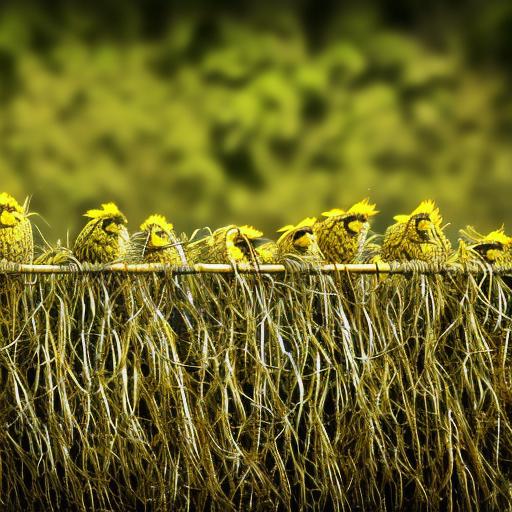Keeping chickens in a coop is a great way to ensure their safety and well-being. It provides them with a secure space to roam and protects them from predators. One of the best ways to keep chickens in a coop is by using a wattle fence. A wattle fence is a type of fence made from woven branches and twigs. It is a traditional method of fencing that has been used for centuries. Building a wattle fence for your chicken coop not only provides a practical solution but also adds an aesthetic appeal to your coop.
Key Takeaways
- Wattle fence is a natural and cost-effective way to keep chickens in a coop.
- Building a wattle fence requires simple materials and is easy to maintain.
- Weaving techniques and securing the fence to the ground are important steps in installation.
- Regular upkeep and repair are necessary to maintain the fence’s integrity.
- Alternatives to wattle fence include wire mesh, wooden, and electric fences.
What is a wattle fence?
A wattle fence is a type of fence made from woven branches and twigs. It is a simple yet effective way to create a barrier for your chicken coop. The branches and twigs are woven together to form a sturdy structure that can keep chickens in and predators out. This traditional method of fencing has been used for centuries and is still popular today due to its simplicity and effectiveness.
To build a wattle fence, you will need branches, twigs, and a few other materials. The branches should be flexible enough to bend without breaking, while the twigs should be thin enough to weave easily. Other materials you may need include wire or string to secure the fence, stakes or posts to support the structure, and tools such as pruning shears or a saw to cut the branches and twigs.
Advantages of using a wattle fence for chicken coop
There are several advantages to using a wattle fence for your chicken coop. Firstly, it is cost-effective and easy to build. The materials needed for a wattle fence are readily available and often free, making it an affordable option for many chicken owners. Additionally, the construction process is relatively simple and can be done by anyone with basic DIY skills.
Secondly, a wattle fence is a natural and eco-friendly option. Unlike other types of fences that require the use of synthetic materials, a wattle fence is made from organic materials that can be easily sourced from nature. This makes it a sustainable choice that has minimal impact on the environment.
Lastly, a wattle fence has an aesthetic appeal that can enhance the look of your chicken coop. The woven branches and twigs create a rustic and charming appearance that blends well with a natural setting. It adds a touch of beauty to your coop while still serving its practical purpose.
Building a wattle fence for chicken coop
To build a wattle fence for your chicken coop, you will need a few tools and materials. As mentioned earlier, you will need branches, twigs, wire or string, stakes or posts, and tools such as pruning shears or a saw. It is important to gather all the necessary materials before starting the construction process.
Once you have all the materials ready, you can follow a step-by-step guide to build a wattle fence for your chicken coop. Start by clearing the area where you plan to install the fence. Remove any debris or obstacles that may hinder the construction process. Measure the space to determine the length and height of the fence.
Next, set up the chicken coop if you haven’t already done so. Make sure it is secure and in good condition before proceeding with the fence installation. The coop should provide a safe and comfortable environment for your chickens.
Preparing the chicken coop for wattle fence
Before installing a wattle fence, it is important to prepare the chicken coop and the surrounding area. Clearing the area is the first step. Remove any vegetation or debris that may obstruct the construction process. This will ensure that you have enough space to work with and that there are no obstacles in the way.
Next, measure the space where you plan to install the wattle fence. This will help you determine how much material you will need and how long the fence should be. It is important to have accurate measurements to ensure that the fence fits properly and provides adequate protection for your chickens.
Setting up the chicken coop is also an important step. Make sure it is secure and in good condition before proceeding with the fence installation. Check for any loose or damaged parts that may need to be repaired or replaced. The coop should provide a safe and comfortable environment for your chickens.
Installing the wattle fence

Installing a wattle fence requires some basic weaving techniques. The specific techniques can vary depending on the materials used and personal preference. However, the general idea is to weave the branches and twigs together to create a sturdy structure.
Start by driving stakes or posts into the ground at regular intervals along the perimeter of the coop. These will serve as support for the fence. Make sure they are firmly planted in the ground to provide stability.
Next, begin weaving the branches and twigs between the stakes or posts. Start at one end and work your way to the other, overlapping each piece as you go. Use wire or string to secure the branches and twigs to the stakes or posts, ensuring that they are tightly woven together.
Securing the fence to the ground is important to prevent predators from getting in. You can bury a portion of the fence underground or use rocks or logs to weigh it down. This will make it more difficult for predators to dig under or push through the fence.
Adding finishing touches can enhance the look of your fence. Trim any excess branches or twigs that may be sticking out, and make sure all the wires or strings are hidden from view. You can also add decorative elements such as flowers or vines to further enhance the aesthetic appeal of your wattle fence.
Maintaining the wattle fence
Regular upkeep is necessary to keep the wattle fence in good condition. Inspect the fence regularly for any damages or signs of wear and tear. Repair any broken or loose branches or twigs to ensure that the fence remains sturdy and secure.
Replacing old fence pieces is also important to extend the life of the fence. Over time, the branches and twigs may become brittle or decayed, making them less effective as a barrier. Replace any damaged or deteriorated pieces to maintain the integrity of the fence.
Additionally, it is important to keep the area around the fence clear of vegetation or debris. This will prevent any potential fire hazards and reduce the risk of pests or predators hiding near the coop.
Challenges of using a wattle fence for chicken coop
While a wattle fence has many advantages, there are also some challenges to consider. One of the main challenges is dealing with predators. Depending on your location, you may have to deal with predators such as raccoons, foxes, or even larger animals like coyotes. A wattle fence may not provide enough protection against determined predators, so additional measures may be necessary to secure your chickens.
Weather conditions can also affect the durability of a wattle fence. Excessive rain or snow can cause the branches and twigs to become waterlogged and weaken over time. Strong winds can also damage or knock down the fence. Regular maintenance and repairs are necessary to ensure that the fence remains in good condition.
Alternatives to wattle fence for chicken coop
If a wattle fence is not suitable for your chicken coop, there are several alternatives to consider. One popular option is a wire mesh fence. This type of fence provides a strong barrier that can keep predators out while still allowing visibility and airflow. It is relatively easy to install and maintain.
Another alternative is a wooden fence. This provides a more solid barrier that offers better protection against predators. However, it may be more expensive and time-consuming to build compared to a wattle fence.
An electric fence is another option to consider. It uses a mild electric shock to deter predators from approaching the coop. This can be an effective solution, but it requires careful installation and regular maintenance to ensure that it is working properly.
In conclusion, a wattle fence is a great option for keeping chickens in a coop. It is cost-effective, eco-friendly, and has an aesthetic appeal that can enhance the look of your chicken coop. However, it is important to consider the challenges and alternatives before deciding on a fence for your chicken coop. Predators, weather conditions, and wear and tear can affect the durability of a wattle fence. Alternatives such as wire mesh fence, wooden fence, and electric fence may be more suitable depending on your specific needs and circumstances.
If you’re considering building a wattle fence to keep your chickens in, you may also be interested in learning about the benefits of renting a chicken coop. Renting a chicken coop can be a convenient and cost-effective option for those who want to raise chickens but don’t have the space or resources to build their own coop. Poultry Wizard offers a variety of rental options, including their popular Chicken Coop Country Diner and Farmhouse Chicken Coop. To find out more about renting a chicken coop, check out their article on poultrywizard.com.
FAQs
What is a wattle fence?
A wattle fence is a type of fence made by weaving branches or twigs together to create a barrier.
Can a wattle fence keep chickens in?
Yes, a wattle fence can keep chickens in as long as it is tall enough and has no gaps or holes that the chickens can escape through.
What are the benefits of using a wattle fence for chickens?
A wattle fence is a natural and sustainable option for keeping chickens in. It also allows for good ventilation and can provide shade for the chickens.
What are the disadvantages of using a wattle fence for chickens?
A wattle fence may not be as sturdy as other types of fences and may require more maintenance. It may also not be as effective at keeping predators out.
What other types of fences can be used to keep chickens in?
Other types of fences that can be used to keep chickens in include wire mesh fences, wooden fences, and electric fences.
Meet Walter, the feathered-friend fanatic of Florida! Nestled in the sunshine state, Walter struts through life with his feathered companions, clucking his way to happiness. With a coop that’s fancier than a five-star hotel, he’s the Don Juan of the chicken world. When he’s not teaching his hens to do the cha-cha, you’ll find him in a heated debate with his prized rooster, Sir Clucks-a-Lot. Walter’s poultry passion is no yolk; he’s the sunny-side-up guy you never knew you needed in your flock of friends!







